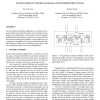Free Online Productivity Tools
i2Speak
i2Symbol
i2OCR
iTex2Img
iWeb2Print
iWeb2Shot
i2Type
iPdf2Split
iPdf2Merge
i2Bopomofo
i2Arabic
i2Style
i2Image
i2PDF
iLatex2Rtf
Sci2ools
WSC
2001
2001
Staging queues in material handling and transportation systems
In most physical queueing applications, customers join a queue and move forward after each service, leaving room for others to join behind them. Some queues found in material handling and transportation systems do not operate like this because the queued entities (pallets or unoccupied cars, for example) are incapable of moving forward autonomously. We develop a model for the resulting staging queue, and give simulation results for several configurations. 1 STAGING SYSTEMS In most finite queueing applications, a customer may join the queue as long as the number of customers in the queue is less than the number of positions in the queue. In a physical system, this is true because customers move forward after each service, leaving room for new customers to join. Some queues in material handling and transportation systems operate differently because customers in the queue do not move forward after each service. One example occurs in rental car lots: typically there are 3
| Added | 31 Oct 2010 |
| Updated | 31 Oct 2010 |
| Type | Conference |
| Year | 2001 |
| Where | WSC |
| Authors | Kevin R. Gue, Keebom Kang |
Comments (0)

